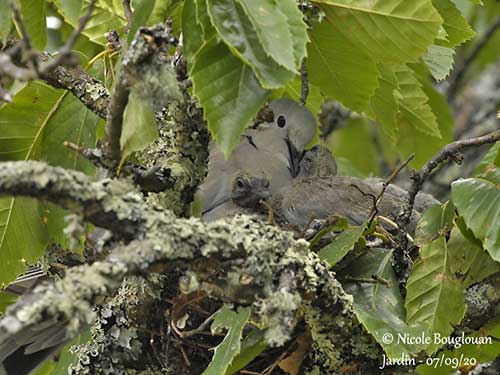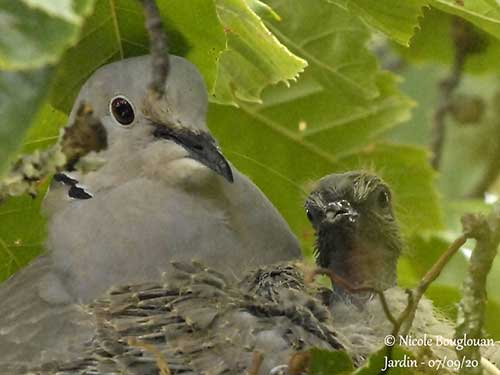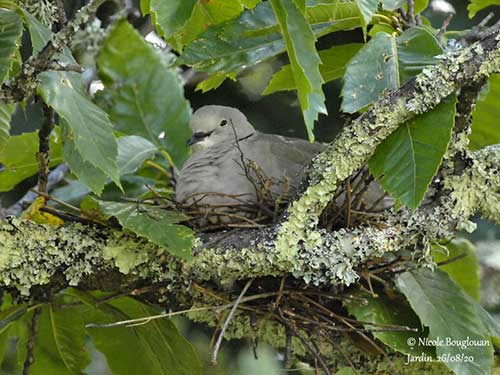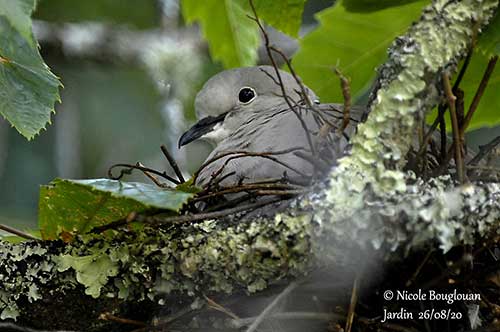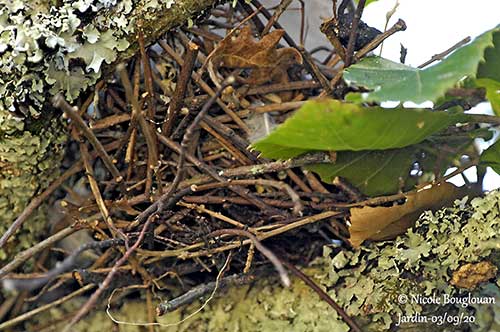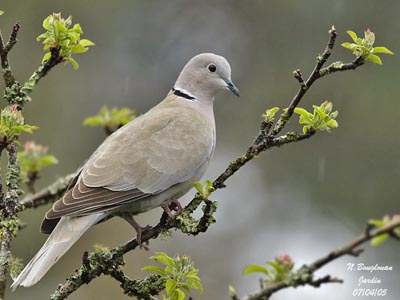
Eurasian Collared-Dove
Streptopelia decaocto
Columbiforme Order - Columbidae Family
The Eurasian Collared-Dove is omnipresent all year round. It is gregarious and we can see groups of several birds at bird-feeders in winter. This species appreciates the sunflower seeds but does not scorn the others. Its cooing more or less accentuated according to the period can be tiresome, but what prettier to look at than two turtle-doves preening each other or touching their bills lovingly? The flight displays produce wing slapping and while the male bows, we can hear soft cooings.
The construction of the nest, even hard, does not lead to an artwork, but rather to a small loose platform made with some coarsely woven twigs, from where the eggs often fall. The nest is usually in tree, shrub, against the trunk, not always well hidden.
BIOMETRICS:
Length: 30-32 cm; Weight: 125-200 g
LONGEVITY: 15-17 years
DESCRIPTION:
The Eurasian Collared-Dove is colonizing the planet, like the House Sparrow or the Common Starling.
The adult male has buffy grey-brown upperparts, but the back is greyer. The flight feathers are darker brown. When the wing is closed, the fore edge appears bluish grey.
The underparts show more pinkish chin, throat, neck sides and chest. On the other hand, belly and flanks are rather pale grey, whereas the undertail coverts are darker. The undertail feathers are dark grey at the base, and definitely clearer, almost white, at tips, except the median rectrices which are grey. The underwing is very pale.

The head shows pale grey forehead and crown, whereas nape and neck sides are more pinkish. At the rear of the head, at neck base, we can see a black half collar edged with white.
The bill is black. The eyes are deep red, with whitish eye-ring. Legs are pinkish.
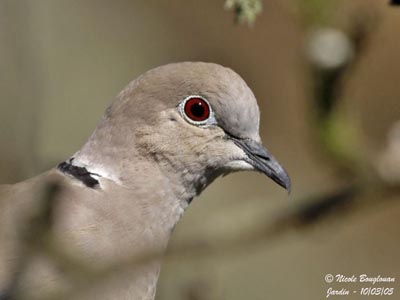
Both sexes are similar, although the female may have slightly browner head.
The juvenile lacks the black half collar, but it resembles adult with paler plumage.
There are two subspecies:
S.d. decaocto (here described and displayed) is found in Europe to Asia Minor, Turkestan and N China, and S to NE Africa, but also in Palestine, Iraq, Iran, India, Sri Lanka and W China. The species has also spread to Middle East, Turkey, Bulgaria, Cyprus and Greece.
S.d. xanthocyclus occurs in Myanmar, including in Shan State, Yunnan and E China. This race is darker than nominate, with yellow eyering instead white.
VOICE: SOUNDS BY XENO-CANTO
The Eurasian Collared-Dove utters monotonous calls including three notes, repeated several times “krou-koou-kou”. While flying, it gives rapid and nasal “kwourrr”, particularly when landing or excited.
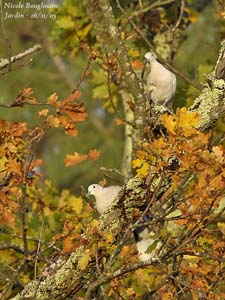
HABITAT :
The Eurasian Collared-Dove lives in towns and big cities, in urban parks and gardens. According to the country, it may frequent semi-desert areas with scattered trees, but also mixed thickets and orchards.
RANGE:
Its original ranges are India, Sri Lanka and Myanmar, and also some parts of Asia. Towards the half of the 20th century, the species extended to the rest of Europe, including into the northern part. It was introduced in the Bahamas into the 1970s and in Florida in the 1980s. Since this period, it gradually colonizes the North American continent.
BEHAVIOUR:
The Eurasian Collared-Doves are often seen in pairs, foraging on the ground, or perched on a branch close to each other. Some of them remain together all year round.
This species is very gregarious, and groups of several birds can be seen at food sources.
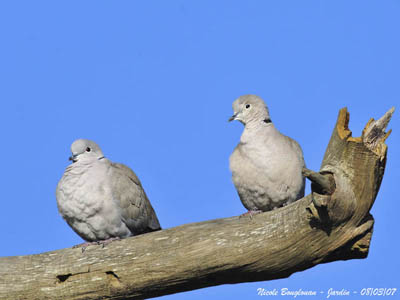
This bird is mainly a grain-eater, taking all kinds of seeds from wild or cultivated plants, but also fruits and berries. It also catches some insects and invertebrates.
It feeds only on the ground, but it may frequent the bird-feeders in winter, mainly with sunflower-seeds. In urban areas, it takes bread crumbs and debris found on the ground.
The most part of the population is sedentary in its range, but young may perform dispersions, according to the country, elevation and seasons.
The courtship displays of the Eurasian Collared-Dove are very beautiful, partially aerial, but also on the ground or in tree. The flight display shows the male taking off abruptly from its perch with noisy wing slapping in order to rise. Then, it flies down by soaring with fanned tail. When it lands, it utters a nasal “kwourrr”.
At other moments, it bows towards the female (which ignores it and goes away) while cooing intensely. If she takes off, it pursues her. At this period, both mates are often seen perched on exposed branch, touching their bill lovingly, as kisses, on head and neck.
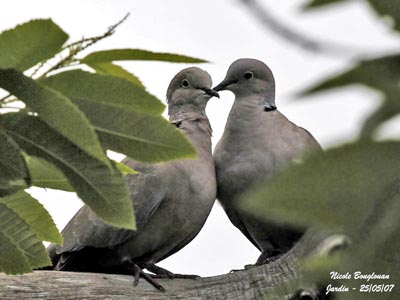
The Eurasian Collared-Dove breeds several times per year, and in temperate areas, the breeding season almost lasts all the year.
FLIGHT:
The Eurasian Collared-Dove performs rapid and direct flight with active wing beats.
It is able to reach speeds of 60 km per hour in direct flight with rapid wing beats. In migration, it flies relatively high.
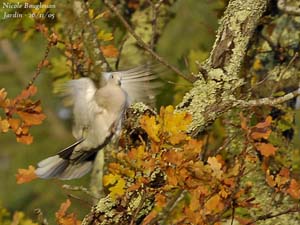
REPRODUCTION :
The Eurasian Collared-Dove nests in shrub or tree, at variable height, between 2 and 20 metres above the ground. Both adults build the nest. It is a loose platform made with coarsely woven twigs. It is common to see the eggs through the bottom, although some nests may be lined with soft grasses. But most of them are very simple. Sometimes, one or both eggs fall down to the ground.
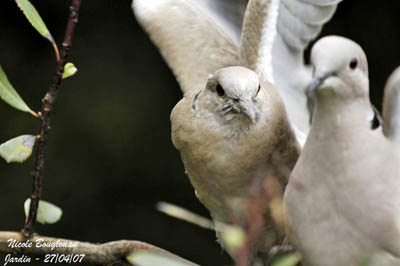
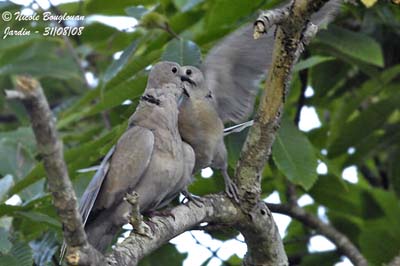
DIET:
The Eurasian Collared-Dove feeds mainly on seeds from cereals and grasses, but it also takes some buds, fruits, berries, insects and other invertebrates. It feeds mainly on the ground, but it also can perform short rising flights to take a berry in a scrub.
PROTECTION / THREATS / STATUS:
The Eurasian Collared-Dove is widely spread in its range. In spite of the owls which are fearsome predators at nest and the birds of prey which are able to kill the adults, numbers are increasing and this species colonizes more and more regions and countries, thanks to the numerous broods every year.
However, in some parts of its range, this bird may become a pest for crops when large flocks damage orchards or cultivated areas.
Fr: Tourterelle turque
All : Türkentaube
Esp: Tórtola Turca
Ital: Tortora dal collare orientale
Nd: Turkse Tortel
Russe: Кольчатая горлица
Sd: Turkduva
Greek: (Ευρασιατική) Δεκαοχτούρα, Δεκοχτούρα, Φιλικουτούνι
Greek (Cypriot): Φιλικουτούνι
Text and photographs by Nicole Bouglouan
Sources:
PIGEONS AND DOVES by David Gibbs, Eustace Barnes and John Cox - Pica Press Sussex - ISBN: 1873403607
HANDBOOK OF THE BIRDS OF THE WORLD – Volume 4 by Josep del Hoyo-Andrew Elliott-Jordi Sargatal - Lynx Edicions - ISBN: 8487334229
Pájaros de España (JL Beamonte)
All About Birds (Cornell Lab of Ornithology)
The female lays two whitish eggs. Incubation by both parents lasts about two weeks. Chicks are fed with “crop milk” including seeds by regurgitation. The young birds leave the nest about 15 to 19 days later, and parents still feed them during one week before they become independent.
This species produces several clutches per year, often 3 to 6 according to the country.
See the complete observation:
